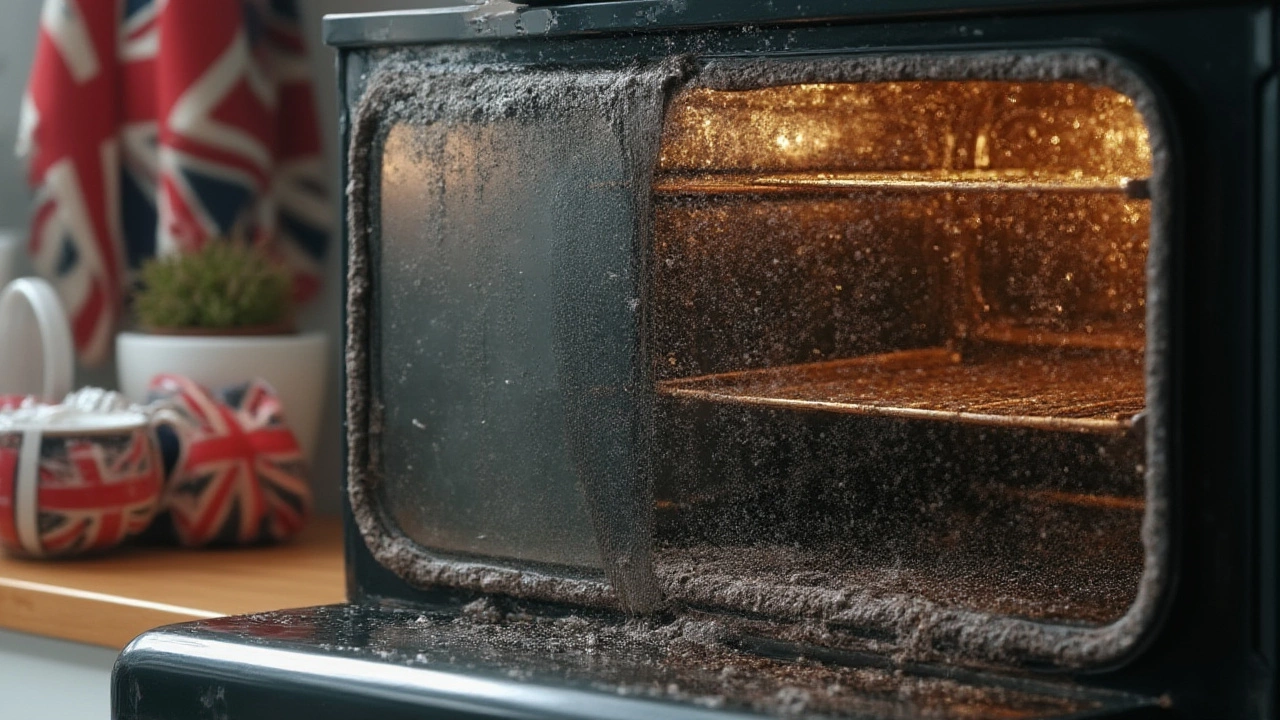Oven disasters happen to the best of us. You bake a pizza, cheese cascades down, and before you know it, you’ve got a layer of black, crusty, unidentifiable something fused to the oven floor. Weeks pass, you promise you’ll clean it, but each time you open the door, it stares at you, daring you to try. Here’s a wild fact: the average oven cavity can heat up over 250°C (480°F) and turn spills into genuine carbon crust, which is why dish soap hardly touches it. That gunk won’t come off with a light wipe. But no, you don’t need to become a chemical engineer—or even buy harsh cleaners that require you to open every window in the house. Stick with this survival guide, and your oven will look nearly new, minus the hassle and the fumes.
The Science of Burnt-On Oven Messes
First, let’s talk about what’s actually happening inside the oven when spills go nuclear. When food, grease, or sauces drip onto superheated metal, a chemical reaction called pyrolysis occurs. This is where organic material—think cheese, sugary sauces, or meat fat—dehydrates and carbonizes, bonding so tightly to metal it might as well have been welded on. Unlike fresh grease, which wipes away with a paper towel, pyrolyzed food can resist even the toughest scrubbing. Have you ever noticed that burnt messes sometimes seem to get harder after every use? That’s because reheating bakes out any last bits of moisture, leaving behind ultra-tough, almost petrified lumps of residue.
Now, modern ovens often come with what’s called a ‘self-clean’ feature—essentially, it superheats the oven to over 500°C (932°F), turning most food residues into ash. But here’s a secret: only about 45% of households actually use the self-clean function regularly, according to a 2024 market study by Consumer Home Trends. Why? Because it locks you out for hours, smells awful, and can stress out your power grid. For the rest of us, removing burnt messes is a DIY battle, so understanding what you’re up against is the first step to winning.
The biggest challenge comes down to the types of residue. Some are sugar-based, which caramelize and turn into stubborn globs that won’t budge without a specific approach. Others are fat-based, requiring more degreasing power. The worst offenders are a combo, like lasagna overflow—grease-soaked, baked-on cheese with tomato sauce. For these, elbow grease alone won’t cut it; you’ll need the right kitchen chemistry.
Different oven finishes also react differently. Enamel-coated interiors can tolerate heavier scrubbing and alkaline cleaners, but stainless steel or exposed heating elements shouldn’t touch anything corrosive. Knowing your oven’s interior surface could save you from accidental scratches or, worse, a voided warranty. Bottom line, each burnt-on mess needs to be matched with its ideal cleaning technique.
The science is clear: time plus heat means stronger bonds. But it’s not hopeless. You can turn this science on its head by using water and gentle heat to rehydrate and loosen burnt food, or by applying baking soda to break down those carbon chains. We’ll dig into these methods next.
Popular Oven Cleaning Myths—Busted
Everyone’s got an aunt or a neighbor who swears by some oven hack they saw on a trending video, but not all advice is created equal. Take ammonia, for example. Sure, it’s a heavy hitter against baked-on grime because its vapors break down heavy residues—but it’s also toxic, potentially damaging to oven parts (especially gaskets), and can leave a nasty stench for days. Another myth? That you need fancy store-bought oven sprays with a bunch of unpronounceable ingredients. Truth is, most commercial oven cleaners are largely lye or caustic soda with a gelling agent—powerful, but also skin-burningly caustic and capable of damaging rubber seals if left too long.
How about the old lemon steam? It’s great for fresh or lightly-baked messes, but once residue has fully carbonized, lemons just aren’t going to cut it. Then there’s the misconception that you can just ‘scrape it off with a metal spatula.’ While this might seem like a shortcut, you risk scratching the enamel or even busting your oven’s heating elements, which can be an expensive replacement. Not a fun way to spend your weekend.
It’s also tempting to blame burnt-on residue on your cooking skills. A survey in 2023 found over 54% of home cooks avoid roasting certain foods because they fear the oven clean-up. But most of the time, the mess comes from overflow, splattering, or baking at high temps, not user error. Pro bakers line the bottom of their ovens with a removable sheet or use a roasting tray if they expect spills. But what if you’re already past the prevention stage? Then it’s time to ignore the fads and lean on tested strategies.
Here’s a short table comparing common oven cleaning myths and the reality behind them:
| Myth | Truth |
|---|---|
| Lemon steam removes all stains | Only loosens minor or fresh residue; no effect on burnt carbon |
| Ammonia is safe for all ovens | Corrosive, risky for gaskets, strong smell remains |
| Store cleaners are always better | Household supplies (baking soda, vinegar) often work as well and are milder |
| Scraping doesn’t harm your oven | Metal tools can damage enamel or heating elements |

Step-by-Step: Effective Home Methods for Burnt Oven Clean-Up
Ready to tackle that carbon crust? Don’t just grab the nearest bottle of cleaner. Here’s a thorough, stepwise plan using things you probably already have at home—safe, effective, and not going to choke up your lungs with fumes. This isn’t a quick fix, but it’ll save you hours of frustration down the line.
- Safety first: Make sure the oven is completely cool. Remove the racks and any loose bits with a brush or vacuum (yes, vacuuming out oven crumbs is a pro move).
- Loosen the worst mess: Place an oven-safe bowl filled with water on the oven floor. Heat the oven to about 180°C (350°F) for 20 minutes. The steam helps soften caked-on grime. Let the oven cool before opening—the steam is hot!
- While it cools, whip up a thick paste of baking soda and water—aim for a peanut butter consistency. Baking soda is mildly abrasive and the sodium bicarbonate helps break down organic residue without scraping your oven.
- Once cool, spread the paste generously over burnt spots (avoid direct contact with heating elements). Spray a little vinegar over the paste if you’re dealing with extra-stubborn gunk—the fizzing helps further loosen it.
- Let the paste sit for at least 8 hours (overnight is perfect). Covering really bad spots with plastic wrap helps the mix stay damp and work longer.
- Next day, use a plastic scraper or old credit card to gently lift away softened residue. Wipe with a damp microfiber cloth, and inspect for any patches you missed.
- For lingering grease or shiny stains, mix equal parts white vinegar and water in a spray bottle. Spritz, let sit for 15 minutes, then wipe clean.
This method works on most enamel ovens and is gentler than anything you’ll buy at the store. Most oven owners notice a dramatic improvement in under an hour of work (excluding the overnight wait). For glass doors, use the same baking soda paste, but skip anything abrasive that could scratch. For racks, soak them in a tub with dishwasher powder and hot water—most baked-on residue will wipe away after an hour.
If your oven sees heavy use, an in-depth clean every season (three to four times a year) stops burnt mess from building up to unmanageable levels. Jot this down: the key to a happy oven is not just scrubbing after big disasters, but doing a little maintenance clean every few weeks.
How Pros Tackle Impossible Burnt-On Oven Stains
Ever wondered what professional cleaners use that you don’t? The real secret isn’t just stronger chemicals. It’s patience, strategy, and knowing the limits of your oven’s surfaces. Pro oven cleaners avoid metal scrapers and instead rely on heavy-duty nylon pads and certified food-safe degreasers—ones way less caustic than old-school lye cleaners. These products often rely on enzyme action, breaking down organic grime over time instead of brute force. A cool trick they use is wrapping oven racks in old towels soaked in degreasing solution. This keeps moisture close to the metal, softening gunk without corroding the steel. After awhile, a rinse leaves racks looking almost new.
Another pro tip: After initial cleaning and scraping, steam the oven once again with water and a drop of dish soap on the oven floor. The detergent bonds with any microscopic grease particles you missed, letting you wipe them away in one final pass. If there are stubborn black spots that won’t budge, an old toothbrush dipped in a baking soda paste works well for detail cleaning. For glass doors, pro cleaners use glass-safe razor blades at an angle, but don’t try this unless you know your oven glass can handle it—one slip can scratch the surface or make it cloudy.
Many commercial ovens now sport “pyrolytic” self-clean features, but even then, pro cleaners warn against overuse—every cycle slowly degrades oven parts. A fun stat: the average UK property management company spends about four times as long cleaning tenants’ ovens as fridges or sinks, simply because burnt-on residue is so stubborn. It’s why the best cleaners invest in methods that require patience instead of risky shortcuts.
The lesson here? Don’t race through the job. Soak, steam, and use gentle abrasion. Quick hacks almost always cost you more time in repairs down the line.

Tips to Keep Your Oven Cleaner for Longer
Nobody wants to clean the oven every other week. Luckily, a few simple habits can save you from burnt-on disasters down the road. Use a baking sheet or oven liner under pizza or casseroles that bubble over—these catch drips before they become science experiments. Just remember to remove liners before self-cleaning cycles! Don’t broil directly on the oven floor—always use a tray.
Get into the habit of wiping up spills after using the oven, while surfaces are warm but not hot. This is when most residues are softest. Every few weeks, do a quick clean with a vinegar-water spray, especially around the door seal where grease can build up. If you cook fatty roasts or bake with cheese often, set a timer for a regular monthly deep clean to avoid big messes setting in.
If you have pets or young kids, make sure cleaners are stored safely—baking soda and vinegar are much less risky than ammonia or lye-based sprays. If you’re eco-conscious, both ingredients break down naturally and won’t harm pipes or pollute your home. And if you’re wondering whether oven liners are safe: stick with ones approved by your oven manufacturer, since cheap silicone mats can melt at high temps and release fumes.
Let’s face it—life’s too short to sweat a dirty oven. With a handful of good habits, a box of baking soda, and some know-how, you can dodge most burnt-on messes without pulling a muscle or resorting to toxic potions. Make it part of your routine, and your kitchen will thank you.
